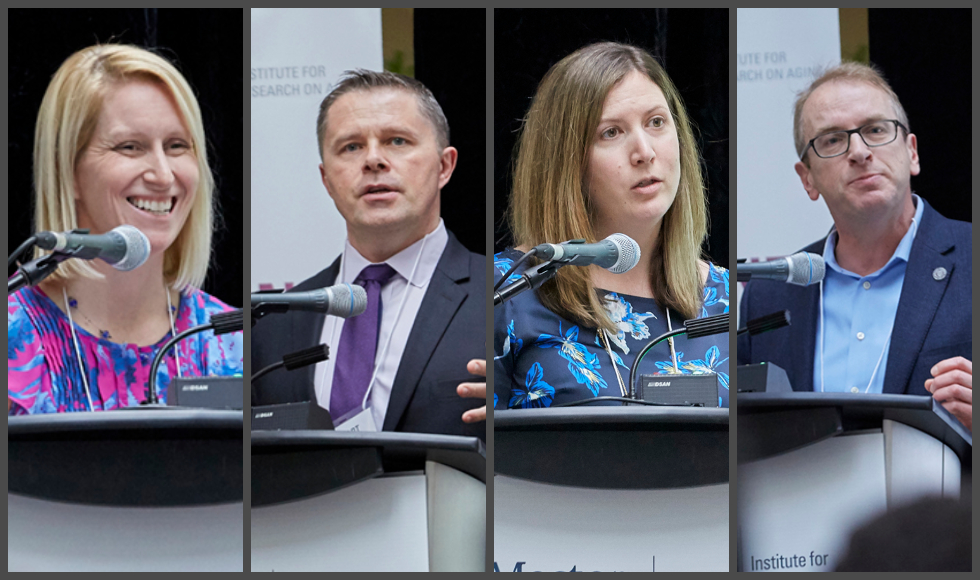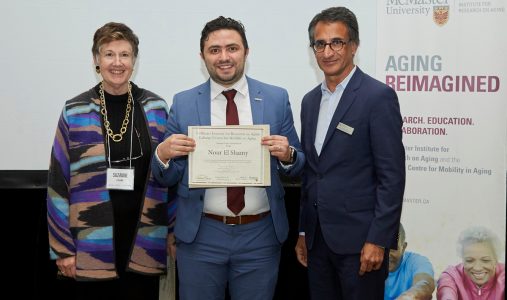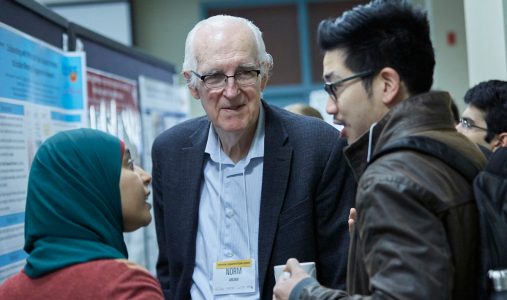MIRA brings together two dream teams for major research projects

Rebecca Ganann, left, Stu Phillips, Marla Beauchamp and Bruce Newbold present their interdisciplinary research projects at MIRA-Labarge Research Day. Photo by Mike Lalich
BY Sonia Verma
December 12, 2018
When the McMaster Institute for Research in Aging set up shop in 2016 and announced it would help McMaster researchers whose work focuses on aging to work together and better combine their expertise, a lot of researchers were skeptical. For such a complicated undertaking, the concept seemed almost too simple.
But researchers trust evidence. And only two years later, the evidence is clear.
“If anyone doubted MIRA could make it happen, they were wrong,” says Marla Beauchamp, assistant professor at the School of Rehabilitation Sciences, and the lead investigator on one of two new projects receiving $1 million through MIRA and the Labarge Centre for Mobility in Aging, which was funded by McMaster Chancellor Suzanne Labarge. Both projects were presented at MIRA-Labarge Research Day this month.
Beauchamp spoke of the all-star team of experts from nearly every faculty at Mac collaborating on her project, which aims to detect early changes in mobility by identifying a “mobility signature” — a pattern of movement unique to individuals, she explains. After that, they will track changes in mobility signatures as individuals age; ultimately, they hope to predict and pre-empt changes in mobility based on their early tracking.

‘Dream big’
The team has their work cut out for them over the next five years, Beauchamp says. First, they need to identify what to consider part of the mobility signature: Is it your heart rate, how quickly you move, how fast you recover from activity, how often or how far you move, the way your body physically moves in its space, or a combination of these and other factors?
Beauchamp, a physiotherapist, will work on this part of the project with occupational therapist Brenda Vrkljan and Julie Richardson, assistant dean of graduate studies in the School of Rehabilitation Sciences.
Once they’ve established what constitutes a mobility signature, Beauchamp’s team hopes to create wearable technology with sensors that will record and track all aspects of the mobility signature, including how and where the individual moves. Engineer and sensor expert Qiyin Fang and geographer Bruce Newbold are a key part of this stage of the project.
After that will come the detailed analysis of the huge amount of data they collected. That’s where Manaf Zargoush, a health-care data analysis expert from the DeGroote School of Business comes in. He and Ayse Kuspinar from the School of Rehabilitation Sciences will put the numbers to work.
“It builds on little pieces of each of our prior research, but we’re taking it somewhere entirely new,” Beauchamp says of the interdisciplinary team, which comprises more than two dozen researchers from across disciplines. “MIRA has introduced us to researchers we’d never met or dreamed of working with.
“It’s ambitious, I know,” she continues. “But MIRA told us to dream big, and we are.”

Real-world solutions
Rebecca Ganann, co-leader of the other major research project, says MIRA helped her assemble a team of more than 20 experts from across disciplines and faculties.
“MIRA has fostered partnerships that could have taken much longer to develop on campus,” she says. “The team has really come together well, with people sharing their expertise and helping us to strengthen the proposal and our commitment to implementing our project.”
Ganann’s EMBOLDEN trial aims take research on mobility out of labs and into the community, where researchers will work with residents and community partners to co-design programs and interventions related to physical activity and nutrition for older adults.
“We know these things are really important for health, for maintaining quality of life,” says Ganann, who leads the project with kinesiologist Stu Phillips. “We also know it’s really challenging for many people to do these things.”
Residents, especially older adults, face barriers when it comes to access to services, awareness of services and sometimes the appropriateness of services, Ganann notes.
“There hasn’t been a ton of real-world application to say what works with diverse populations,” she says. “There’s a gap, and that’s why we want to make sure that what we’re developing makes sense for the real world.”
With feedback and help from community organizations and residents, Ganann and Phillips’ team will work to figure out what interventions help, what is feasible, and how existing resources can be improved.
“We’re not just going to ask what an intervention should be, based on our research evidence. We want to work with the Hamilton community to learn what it should look like, and how we can start to address some of the barriers to supports and services? How do we get people out who haven’t necessarily been heard before? How do we deliver services in a way that will help to foster those types of community connections and ultimately enhance mobility?”
A lot of research into mobility has been conducted in labs, and not everyone is able or willing to come to a university campus for research, Ganann points out. “We’re hoping to find something that’s a better fit for a broader range of people.”
The McMaster Institute for Research on Aging (MIRA) aims to optimize the longevity of Canada’s aging population through research, education, and collaboration. Interdisciplinary teams work alongside older adults and key stakeholders to find ways that will help Canadians spend more years living well. MIRA also acts as an entry point to some of McMaster’s existing research platforms in aging, including the Labarge Centre for Mobility in Aging and the McMaster Optimal Aging Portal. For more information, go to http://mira.mcmaster.ca/


